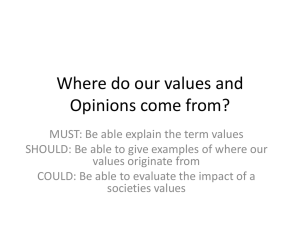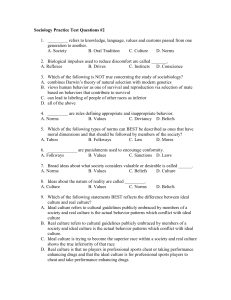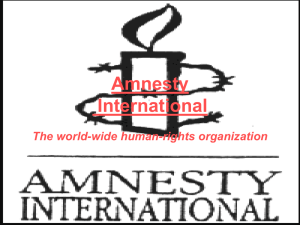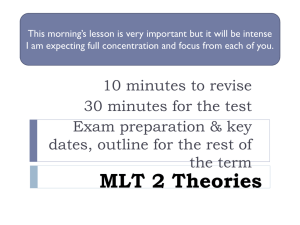January Revision Guide
advertisement
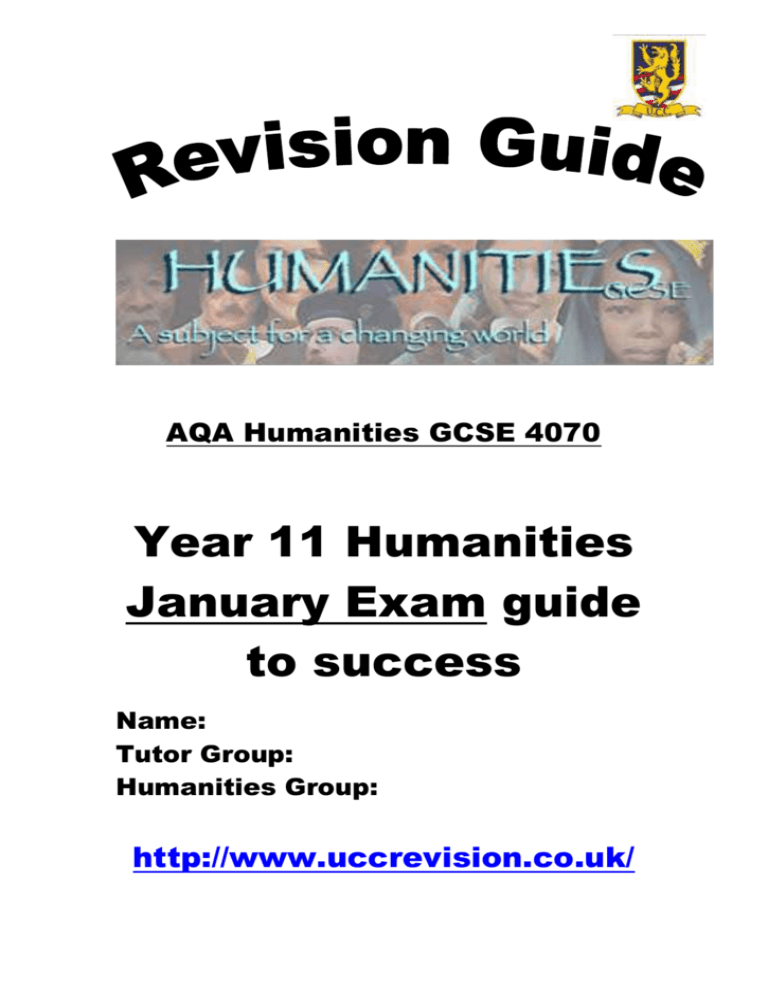
AQA Humanities GCSE 4070 Year 11 Humanities January Exam guide to success Name: Tutor Group: Humanities Group: http://www.uccrevision.co.uk/ GCSE January Exam Format Paper 1 2016 - Thursday 21st January In this Paper students are required to answer all questions. Core 1: Culture & Beliefs Option 1: Work and People This paper is marked out of 72 and you will have 75 minutes in the exam to answer all questions 2 Revision ideas Design a revision timetable Condense your notes onto cue cards Practice revision questions Get someone to test you Set up a study group Create a revision poster for each topic 3 Key to exam success Good subject knowledge Good time management skills Read and understand what the question is asking you to do Look at the mark scheme to see how much you need to write Make sure you structure your answers 4 Answering 12 mark questions Three different types of essays: Conventional Essay – Given a list of things to include but only have to choose two and explain them e.g. paragraph for each one. Comparative essay – Produce a paragraph for each side of the argument e.g. Nature Vs Nurture; explaining two views about a moral issue (euthanasia, abortion); etc Source based essay – Ensure you use the sources to reach a Level 3/4 (7-12 marks) e.g. ‘In Source A it says that….’ Golden Rules: Your opening sentence should be a reframing of the question e.g. ‘Nature is important in shaping who we are because...’ Remember to use the PEEE chain! (Point, Evidence and Explanation and Expand). Your explanation at the end of each paragraph should always answer the question e.g. ‘This shows that nurture is important in shaping who we are because humans need to be socialised by other humans to learn correct norms of behaviour’. Use Humanities terminology in your answers to reach a Level 4 (10-12 marks). Use connectives to make your work flow better e.g. in addition; in contrast; as a result; therefore; this shows that; etc. This is the grading system for 12 mark answers: LEVEL 1 (1-3 marks): A simple answer, showing little thought. A brief statement based on sources or your own knowledge. LEVEL 2 (4-6 marks): A descriptive answer based on sources/your own knowledge. Evidence is given, but not developed. LEVEL 3 (7-9 marks): A detailed answer, using relevant examples and generalising sources. Identifying a strand in the question, and developing it. LEVEL 4 (10-12 marks): A clear answer confronting the question, which is sustained, developed and analytical. The answer is judged on breadth (showing a wide understanding) or depth (showing your thought.) 5 Answering 4 mark Questions There are three types of 4 mark questions which can arise in the exam: Source based response e.g. where you have to recall information from a particular Source. Ensure you explain two points to achieve full marks. Recall questions asking for two ways e.g. ‘Briefly explain two ways in which a large-scale ecosystem is being destroyed.’ One mark is given for identification of method and one mark for example / explanation (Deforestation is one way that the Amazon Rainforest is being destroyed, as mahogany trees are cut down to make furniture). 4 mark recall questions e.g. where you have to provide a paragraph response showing you understand terms and phrases (see example below). Sample Answer From your own studies, explain how the family influences a person’s identity. (4 marks) A family influences a person’s identity in two ways. First, the person’s family name and the people he/she is related to are part of someone’s identity. This is how they are known by other people. The other way a person’s identity is influenced by the family is by the way they are brought up. The family teaches them basic social skills, like language and how to eat, but also the person copies the way the family behave and learns their attitudes and beliefs. They will think that the family’s ideas and attitudes are normal. So if a person is brought up in a polite family they will be polite, and if the family is argumentative and violent they are likely to be the same. A person’s identity comes from the way they behave with others, so the family will be a big influence. Links Socialisation to identity Explanation of Socialisation Example and explanation of effects of Socialisation Socialisation 6 Case Studies Task 1 Make a mind map for each of the examples with as many points as you can remember. Task 2 Make up a question where you would need that case study to be able to answer it. Culture and Beliefs Yanomami Culture Amish Culture British Culture (multiculturalism) Nature-Nurture - Jim Twins, William from Child of Our Times, Oxana Malaya, The Gay Gene Euthanasia case study – know an example Culture and Belief Keywords Culture The accepted way of living in a society or nation; includes attitudes to and preferences for food, work, education, family life, housing, etc. Values Principles or standards. Our judgements about what is right or wrong. No culture is made up of people who think exactly the same, but in most cultures there are some things that are generally agreed upon. For example, in the UK, most people think it is wrong to kill or to steal. Norms Ways of behaving which are expected by other members of a culture. If people do not follow the norms they may be seen as strange, threatening or mad. Examples of norms are wearing clothes in public and saying thank you if someone does something for you. Beliefs Something we hold to be true; when we talk about beliefs we may be referring to religion, 7 values, morals, traditions or ambitions. Attitudes A settled way of thinking or a state of mind. For example, people from one culture may think that the way other cultures live is less good than their own; they may say others; lifestyles are stupid or cruel Customs and traditions Ways of behaving which have been handed down from generation to generation for many years. These are accepted as being the right way to behave within a culture. UK examples include eating Christmas dinner, sending cards for birthdays, getting married following a set ceremony. Deviance Not conforming to the norms of their culture. Morals Provide guidance on what is right and wrong. religion A system of beliefs about life, death and the mysteries of the physical and spiritual world. Ritual An event that expresses some religious meaning. Rites of passage A ceremony or event that marks an important stage in a person’s life. subculture A culture that exists within the dominant culture and has many similarities, but also significant differences. Indoctrination When someone attempts to make you accept certain facts and ideas without question Eugenics The study of ways to improve human inheritance. Identity-giving An act or process that defines part of a person’s identity. Gender identity All of the attributes and characteristics that are associated with belonging to one or the other of the sexes. 8 Ethnic group A group with a distinct culture that can be traced through history to a specific location. Social Identity When a person is identified or labelled as a specific type of person. Multiple Identities When a person has a number of identities in different parts of their life. Nature When a person has a number of identities in different parts of their life. Nurture when a person learns from their experiences, environment or training Issue Something about which people have different views A viewpoint that a person or group has about an issue A person classed as a refugee fleeing persecution. He or she is not an economic migrant. A group with a distinct culture that can be traced through history to s specific location. When two cultures combine and live alongside each other in harmony. When an ethnic group adopts the host culture as their own. A society which consists of the culture of several different races. A human child who has lived away from human contact or bought up with little experience or very poor care. Perspective Asylum seeker Ethnic group Integration Assimilation Multicultural Feral child 9 Unit 1:Culture & Beliefs Appearance Aesthetics Religious beliefs What makes up a person’s culture? Roles Traditions/customs Morals Values Language Attitudes Definitions Culture – The shared way of life of a particular society Norms – Ways of behaving which are expected by other members of a culture e.g. men do not wear make up in the UK. Customs/Traditions – Ways of behaving which have been passed down from generation to generation e.g. Christmas dinner. Primary Socialisation – First stage of teaching people how to fit into society (usually done by parents) Secondary Socialisation – Other agents involved in socialisation. Education Family Laws Mass media Agents of Socialisation Religious groups Role models Workplace Task: Learn the different agents of socialisation and briefly explain how each teaches us culture: norms, values, beliefs and traditions shared by a group of people Peer groups 10 Nature vs. Nurture debate Case Study: Kamala & Amala, the ‘wolf girls’ Case Study: Oxana Malaya Nature Nurture What you inherit e.g. Genetic information such as IQ, hair/eye colour. Jim Twins Case Study What you learn through experiences (Agents of Socialisation) Oxana Malaya/ Wolf Children Case Study Importance of beliefs to a culture Case Study - Amish Do not wear buttons because they are seen as proud and they want to remain humble. Some Amish men grow beards as a sign that they are married They do not join the army as they believe in peace Beliefs and Practices Case Study - Christianity Believe in God (practice) to attend church on Sunday. Believe Jesus born on 25th Dec (practice) to celebrate Christmas. 11 Moral Issues Other Examples Case Study - Euthanasia Abortion Capital Punishment War Poverty Global Warming Human Cloning Divorce Plastic Surgery Immigration 1.) Pro-life alliance (against) - Life is a gift from god - Change the role of a doctor - Christianity teaches that life is sacred and should be protected until a person dies naturally. 2.) Voluntary Euthanasia Society (for) - People should have the right to decide when and how they die - It can quickly and humanely end a patient’s suffering. Diffusion of ideas Inventions & new technology Wars & revolutions How do Cultures change? Globalisation Monarchy & Governments Multiculturalism Environment Migrants 12 What is culture? - Shared way of life in a community or group - Norms, values, customs, traditions, beliefs, attitudes & practices Case study - Plains Indians of North America • Few laws within the tribe • Safety of whole tribe more important than individuals • Very old sometimes left to starve • Men in warrior clubs • Sun dance linked to religious beliefs • Ritual dances to bring buffalo back Case Study - Yanomami of South America • live in rainforests and mountains of north Brazil • 95% of the tribe will live in the rainforest • 5% of the tribe will live by the river, to encourage trade and be able to fish • extended family units of between 150 - 400 people • large huts known as SHABONOS • men go on long distance hunting trips • men are allowed to marry a numerous amount of wives problems faced: • gold miners pollute rivers • cattle ranchers destroy vegetation • number of cases of malaria is rising How is order maintained in a culture? Social Norms • acceptable • norms can change within a culture • social deviants do not conform with society Laws • Enforcers of law include: government, judiciary, penal system, police and army • Common law may enforce norms Morals • guidance on what is right and wrong • religion Values • what individuals believe to be important 13 Interaction of cultures - Britain is a multicultural society - Minority cultures find it hard to maintain culture in Britain as they are put under pressure by community. Problems migrants face: • unemployment • nowhere to live • racial discrimination • can cause riots - 3rd Race relations act of 1976 outlawed discrimination and established the Commision for Racial Equality What are Human Rights? TASK: Read this information and make a mind map that includes information on human rights and different organisations (including Amnesty International) that works to promote and defend human rights across the world. http://www.youtube.com/watch?v=oh3BbLk5UIQ This is an excellent resource that summaries the history and development of human rights. 14 In 1945, after the horrors of World War II, an international organization was established, the United Nations. It was dedicated to maintaining peace and security and to solving humanitarian problems. So in 1948, they developed a code of conduct for the protection of basic human rights to be used across the world. This was called the Universal Declaration of Human Rights. It is not legally binding, but its content has been incorporated into the laws of many countries and it has become a standard measure of human rights across the world. However, there are still many countries and people who abuse these rights for example;- The Articles of the Universal Declaration of Human Rights were set up to protect people . In the UK they are included as part of our laws. Not all countries do this!!! There are 30 articles in the Universal Declaration of Human Rights- here are the first 11 in order they appear in the Declaration 1. Right to Equality 2. Freedom from Discrimination 3. Right to Life, Liberty, Personal Security 4. Freedom from Slavery 5. Freedom from Torture and Degrading Treatment 6. Right to Recognition as a Person before the Law 7. Right to Equality before the Law 8. Right to Remedy by Competent Tribunal 9. Freedom from Arbitrary Arrest and Exile 10.Right to Fair Public Hearing 11. Right to be Considered Innocent until Proven Guilty 15 What is Amnesty International? • Amnesty is an impartial organisation that works to defend human rights by lobbying governments. • Using the principle of “non-violent direct action”, Amnesty asks people to write letters, or to send faxes and e.mails to highlight the cases of prisoners of conscience or victims of human rights abuses. • Amnesty has more than one million members and supporters in more than one hundred and forty countries • Amnesty is an impartial organisation that works to defend human rights by lobbying governments. • Using the principle of “non-violent direct action”, Amnesty asks people to write letters, or to send faxes and e.mails to highlight the cases of prisoners of conscience or victims of human rights abuses. • Amnesty has more than one million members and supporters in more than one hundred and forty countries How Amnesty International Began The organisation was launched in 1961 by Peter Benenson, a British lawyer, after reading about two Portuguese students who had been sentenced to seven years in prison for raising their glasses in a toast to freedom. After publishing a newspaper article on the case, he received more than 1,000 offers of support for the idea of an international campaign to protect human rights How does AI work? • Research is carried out to investigate possible violations of human rights. This is carried out by expert staff who work in a range of fields such as law, medicine, media and technology. • Amnesty then lobbies government(s) concerned in order to highlight the case and to ask for an end to the human rights abuse. • Amnesty asks individuals to lobby governments by writing letters etc. • Amnesty also runs general campaigns to highlight issues. The “STAMP OUT TORTURE” is an example of such a campaign. 16 Culture & Beliefs Exam Questions: Below are some practise exam questions. As part of your revision, try and answer a question before checking your notes and then improve it to get full marks! From your own studies, name two religions. (2) How may religious beliefs influence a person’s behaviour? Briefly explain, using your own studies. (2) What do you understand by ‘the media’? Use your own studies to answer. (2) Give the meaning of the term ‘culture’. (2) Give an example of two different cultures. (2) Explain one way in which a person’s beliefs may influence how they behave. (2) Explain two ways in which the media may influence a person’s behaviour. Use your own studies to answer. (4) Explain why mutual respect and understanding are important in multicultural societies. (4) Explain two effects of immigration. (4) Choose a moral or a social issue. Write a short essay to explain at least two different views on the issue. In your answer you should: Name the issue; describe the different views; explain why people hold these views. (12) People have different views about the importance of nature and nurture in shaping who we are. Write a short essay about the nature/nurture debate. In you answer you should: Explain the different views; use examples from your studies; give your own conclusion on the debate. (12) Explain why Britain might be described as a multicultural society. Use information from your own studies in your answer. You could include: Language; art; music; signs and symbols; religions. (12) 17 Option 1: People and Work Q 1a 18 Q 1b What are Satisfaction Factors? • • • • • • • • • • Working conditions Ability to use our own creativity & initiative Opportunities for promotion Level of wages Attitude of employer/superiors Technological support Holiday entitlement Perks/Benefits Helping others/ serving the public Danger, excitement and challenge 19 Q 1c Unemployment - A person is classed as unemployed if not only out of work, but also actively looking for work and available to start work within a fortnight. • Unemployment figures are based on a survey carried out by the Office for National Statistics (ONS). They show the average number of people unemployed over a three-month period. BBC link 20 Why do Jobs Disappear? Q 1d Questions: • Define what we mean by being UNEMPLOYED. (Give examples) 2marks • Why might unemployment suddenly increase? 4 marks • Explain the impact of unemployment on: an individual/ family/ community. 12 marks 21 Q 1e 5. Mechanisation 5. The move from craft production to making things by machine production e.g. textile industry. 22 Q 1f Now try out these questions… i)What are the main differences between car production in the 1900s and modern day car production? Use your own studies. ii)How has technology made a difference to businesses over the last 10 years? Use your own studies to answer. iii)Explain and evaluate how information technology has affected people’s attitude to work. What case studies & sources have we used? Mini Foot and Mouth 2009 Floods Unemployment Statistics – Penrith Coal Mining Shipbuilding Abraham Maslow Traditional V Modern Farming Trade Unions and Conflict in Business Q 1g CONFLICT IN BUSINESS ORGANISATIONS- WHY DOES IT HAPPEN? Less efficiency Changes in terms and conditions for employees- i.e. have to work more hours for less pay/ changes to pensions (think about teachers and firefighters strikes) High levels of absenteeism High labour turnover (% of employees leaving in a year) INCREASED Customer complaints FORMAL GRIEVANCE AND DISPUTE PROCEDURES SHOULD BE ADOPTED TO AVOID CONFLICTS 23 SOURCES OF CONFLICT Some of the issues that can cause conflict between individuals and groups at work include: Q 1h ineffective or insufficiently trained management unfair treatment unclear job roles poor communications poor work environment lack of equal opportunities bullying and harassment unresolved problems from the past an increase in workload. MAJOR UK ORGANISATIONS INVOLVED IN INDUSTRIAL RELATIONS 24 TRADES UNION CONGRESS (TUC) The TUC is the voice of Britain at work. With 58 affiliated unions representing 6.2 million working people from all walks of life. Campaign for a fair deal at work and for social justice at home and abroad. They negotiate in Europe, and at home build links with political parties, business, local communities and wider society. TRADES UNION CONGRESS….AIMS ACT AS A PRESSURE GROUP REPRESENT TRADE UNION VIEWS IN GENERAL INFLUENCE EMPLOYERS ASSOCIATIONS INFLUENCE GOVERNMENT POLICIES CONFEDERATION OF BRITISH INDUSTRY (CBI) Premier lobbying organisation for UK business on national and international issues. The Confederation of British Industry's mission is to help create and sustain the conditions in which businesses in the United Kingdom can compete and prosper for the benefit of all. Q 1i Advisory, Conciliation and Arbitration Service (Acas) What they do: ACAS provides information, advice, training, conciliation and other services for employers and employees to help prevent or resolve workplace problems. Disputes and conflict in the workplace Conflicts at work take many forms. It might be an individual with a grievance, a problem between an employee and a manager or conflict between two co-workers. Any conflict can get in the way of work and make your business less productive. Dealing with conflict at an early stage to nip it in the bud and stop the situation developing into a full-blown dispute will save time, money and stress later on, for both the employer and employees. SERVICES PROVIDED BY ACAS ADVICE AND INFORMATION: TO EMPLOYERS AND EMPLOYEES ON ALL AREAS OF EMPLOYMENT CONCILIATION: TALK TO BOTH SIDES AND SETTLES DISPUTES AMICABLY. 25 ARBITRATION: IF A SITUATION HAS REACHED A ‘DEAD LOCK’, ACAS ARRANGES FOR AN INDEPENDENT GROUP TO LISTEN TO BOTH SIDES AN ARRIVE AT A FAIR SETTLEMENT. Trade Unions- Representing Workers Q 1j A trade union is an organisation with members who are usually workers or employees. It looks after their interests at work by doing things like: negotiating agreements with employers on pay and conditions discussing big changes like large scale redundancy discussing members’ concerns with employers going with members to disciplinary and grievance meetings How Are Trade Unions Financed? Each trade union member pays a subscription People pay their subscription fees in different ways It may be collected by direct debit from your bank account deducted directly from your wages paid in cash or by cheque to your union representative or full time official. 26 27 Q 1k 28 29 Useful Websites Humanities Exam Board - http://www.aqa.org.uk/ Ensure you look at the New Humanities Specification if you enter this website. School website – http://www.ullswatercc.co.uk/ Culture & Beliefs 1.) www.abortionrights.org.uk 2.) www.dignityindying.org.uk 3.) www.amnesty.org.uk People and Work 1) http://www.ons.gov.uk/ons/taxonomy/index.html?nscl=P eople+in+Work 2) http://www.dailymail.co.uk/news/article-2743430/Britains-economy-storms-ahead-Number-people-work-UKrises-rest-EU-together.html 3) http://www.hse.gov.uk/youngpeople/ 4) http://www.acas.org.uk/index.aspx?articleid=1461 5) http://www.bbc.co.uk/news/health-34915820 Junior doctor dispute 'to go to Acas' 30

